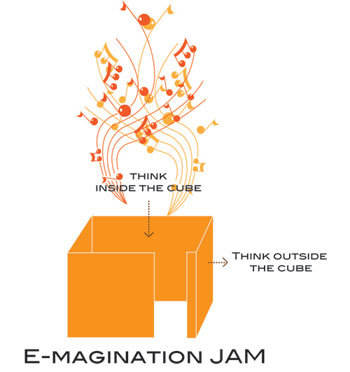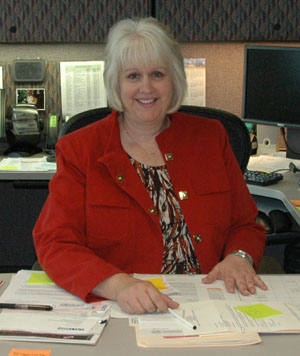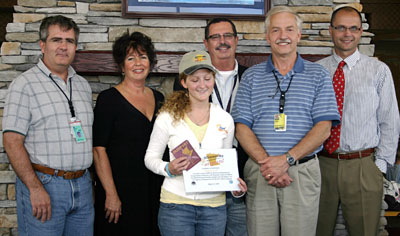 |
|

|
 |
TABLE of CONTENTS
 |
State Fair visitors stop by Mn/DOT booth |

Stephany Osuji, Seeds student worker, offers a conehead cutout to one of the many Minnesota State Fair visitors venturing to the Mn/DOT display on opening day, Aug. 27. In the week since the State Fair started, visitors have asked Mn/DOT staff a variety of questions:
- Can I have a state highway map?
- What is an accessible pedestrian signal?
- Where’s the snowplow?
- Why is Mn/DOT installing roundabouts?
- How do I get a copy of my driving record?
Located in the Education Building at 1372 Cosgrove Street (north of Dan Patch Avenue), Mn/DOT’s booth provides fairgoers with a variety of transportation information, including the new 2009-2010 state highway maps.
Under the theme of “Your Destination…Our Priority,” Mn/DOT’s booth focuses on ways the department is ensuring that transportation dollars are spent effectively to provide a safe, efficient and sustainable transportation system. Photo by Nick Carpenter
|
|
 |
|

|
 |
TABLE of CONTENTS
 |
Mn/DOT finalizes 20-year Statewide Transportation Policy Plan |
On Aug. 21, Mn/DOT finalized the 2009-2028 Minnesota Statewide Transportation Policy Plan.
The plan, “Your Destination...Our Priority,” sets a long-range vision for transportation in Minnesota and identifies transportation system needs, goals and priorities for the next 20 years.
“Accountability and transparency were important in developing this plan,” said Commissioner Tom Sorel. “We sought input from the public and stakeholders who help guide our future investments and decisions. The result is a policy plan for developing and maintaining a safe, efficient transportation system for the future.”
Last updated in 2003, the plan is based on analysis of transportation trends and issues in Minnesota. The plan differs from its predecessor in that it identifies some new challenges including a growing, aging and more diversified population as well as energy and environmental concerns. It also highlights some opportunities for new approaches to improve safety, manage congestion and expand alternative modes of transportation.
Multiple planning efforts for other modes are also underway that will expand upon the policies and strategies of the plan, including the Greater Minnesota Transit Plan, Intercity Bus Study and the Statewide Freight and Passenger Rail Plan.
“The plan is multi-modal and multi-jurisdictional,” Sorel said. “It outlines strategies to move Minnesota forward and identifies where Mn/DOT and partners should work together to meet the state’s transportation needs.”
Mn/DOT has concurrently updated the Statewide and District Highway Investment Plans for the 2009-2028 time period. The plan lays out priorities for projected available funding during the next 20 years.
“It establishes a balanced program of investments that help achieve strategic priorities of safety, mobility and infrastructure preservation,” Sorel said. “But it’s just a snapshot in time. It may change as future revenue and costs change.”
To view the Minnesota Statewide Transportation Policy Plan and the Statewide and District 20-year Highway Investment Plans, visit http://www.dot.state.mn.us/planning/stateplan/index.html. |
 |
|

|
 |
TABLE of CONTENTS
 |
Pilot program offers jobs to low-income candidates, saves department money |
|
By Lisa Yang
Offices and districts that have temporary or permanent positions open can now hire prescreened, qualified candidates through the Mn/DOT-DHS Partnership Program while only paying half of their salary.
Mn/DOT and the Department of Human Services created the pilot program to provide entry-level job opportunities to people enrolled in the Minnesota Family Investment Program, which provides government assistance to low-income families with children. Referred candidates will need to meet minimum qualifications and compete for open positions.
If a candidate is hired through the program, DHS will fund 50 percent to 100 percent of the salary until June 30, 2010. After that, the office or district may choose to fully fund the position.
“The timing is perfect for this especially because of budget cuts,” said Emma Corrie, recruitment programs manager. “Offices and districts will get qualified candidates who meet requirements, but they won’t have to pay for the entire salary.”
DHS will prescreen and identify candidates for Mn/DOT offices and districts to interview based on the minimum qualifications for open positions. They also will provide on-going job coaching for candidates hired through the program.
“These positions will provide our candidates with valuable on-the-job work experience in today’s economy,” said Jim Olson, DHS policy analyst and lead partner for the program.
Although positions are not restricted to any specific job classifications, they would likely be entry-level positions that could include transportation specialist series, clerical, building maintenance and laborer positions.
Offices and districts may request to fill a position through the Mn/DOT-DHS partnership program by contacting Emma Corrie at emma.corrie@state.mn.us, 651-366-3378, or Jessica Etukudo at jessica.etukudo@state.mn.us, 651-366-3375. |
 |
|

|
 |
TABLE of CONTENTS
 |
E-magination Jam offers employees chance to ‘think outside the cube’ |
|
 By Chris Krueger By Chris Krueger
Employees in every corner of the state will have an opportunity to further develop Mn/DOT’s strategic vision when E-magination Jam launches into cyberspace on Sept. 14.
The initiative creates a virtual collaboration space where employees can offer ideas that may save the department money or improve processes that will allow offices and divisions to perform their jobs in ways that better serve the public. Ideas can be posted around the clock through midnight, Sept. 18.
Susan Hall, initiative manager in the Office of Policy Analysis, Research and Innovation, said the project was created to mine the collective creative energy of all Mn/DOT employees.
“The commissioner’s recent survey revealed that employees feel the department is going in the right direction and they want to provide input,” Hall said. “E-magination Jam provides that opportunity.”
Commissioner Tom Sorel will kick-off E-magination Jam with a webcast that will air at 10 a.m., Sept. 14. After the Commissioner’s address, employees will be able to share ideas online using a software program that makes online dialogue possible.
“Employees will be able to generate their own positive, unique ideas as well as add to the contributions offered by others,” Hall said. “The idea is to maximize the wisdom of crowds, which means that great ideas can come by people working together.”
Employees are encouraged to submit ideas that relate to Mn/DOT’s five strategic directions: safety, mobility, innovation, leadership and transparency.
“Linking ideas to the five strategic directions provides focus to a conversation that could have a wide-ranging scale,” Hall said. “Employees will have an opportunity to name one safety initiative they would like to implement to move Mn/DOT forward or propose a small change that would improve mobility for Minnesotans.”
The best ideas generated by the online brainstorming session may be eligible for Destination Innovation funding.
Employees participating who choose to identify themselves also will get credit for the idea. In addition, all participants will receive a button in appreciation for their time and contribution.
Supervisors are encouraged to let employees use work time to participate in the online jam session. Employees who choose to log on outside of work can do so at anytime from any computer.
To learn more about E-magination Jam and how to log in on Sept. 14, visit http://www.dot.state.mn.us/EmaginationJAM/
Questions to ask yourself
- Do you have an innovative idea that could make a big difference in the state or would win a top award in government?
- Is there an issue we need to understand better to deal with the unique circumstances we face in transportation today?
|
|
 |
|

|
 |
TABLE of CONTENTS
 |
Celine Carpenter joins Commissioner’s Support Team as executive assistant |

Celine Carpenter has been with Mn/DOT for more than 30 years serving as administrative assistant to several offices. Photo by Lisa Yang |
Celine Carpenter began her position as executive assistant to the Commissioner on Aug. 24. Her duties include a full range of executive administrative support to the Commissioner, including:
- Managing the commissioner’s correspondence to ensure items are tracked, reviewed and responded to within appropriate timelines.
- Managing the commissioner’s telephone calls and, as requested, e-mail messages to ensure that contacts are responded to as appropriate.
- Assessing office needs, supporting agency vision and mission and identifying the appropriate ways and people to meet those needs.
Carpenter has been with Mn/DOT for more than 30 years serving as administrative assistant to several offices including Right of Way, Finance, Human Resources and, most recently, to the Operations Division.
“Celine brings a wealth of experience to this position,” said Rebecca Fabunmi, special assistant to the commissioner. “Her capabilities and persona are a wonderful addition to the Commissioner’s Office and our team.”
Along with Fabunmi, Carpenter joins Nancy Stone, special projects assistant, and Heidi Bryand, administrative assistant, on the Commissioner’s Support Team.
“This is an exciting opportunity and a great team to be part of,” Carpenter said. “I’m looking forward to assisting in the achievement of the Mn/DOT mission.”
Carpenter can be contacted at 651-366-4802, or by e-mail at celine.carpenter@dot.state.mn.us. |
 |
|

|
 |
TABLE of CONTENTS
 |
FHWA Minnesota Division renovates Web site |
The Minnesota Division of the Federal Highway Administration recently redesigned and reconfigured its Web site to help customers find what they are looking for.
Terrence Beltz, information management/marketing specialist for FWHA, said he decided to make the site more accessible after doing some market research and talking to customers.
“The new site is much easier to use, with better access to the information people want,” said Beltz. “It’s amazing how much is out there and how much information we have available.”
To view the renovated FHWA Minnesota Division Web site, visit http://www.fhwa.dot.gov/mndiv/.
|
 |
|

|
 |
TABLE of CONTENTS
 |
Mn/DOT's historic roadside structures program receives national recognition |
|
By Bob Filipczak
|
Before-and-after photos of the roadside historic area next to Split Rock Lighthouse north of Duluth show a restored stone retaining wall. The project was funded in part by the Coastal Zone Management Act, NOAA's Office of Ocean and Coastal Resource Management, in cooperation with Minnesota's Lake Superior Coastal Program and the Federal Highway Administration National Scenic Byways Program.
Photos by Liz Walton and Kathryn McFadden |
It’s easy to drive right by them. Unlike great historic buildings and monuments, Minnesota’s roadside historic areas, such as retaining walls or outdoor fire pits, are sometimes easy to overlook.
Last spring, however, the Federal Highway Administration gave its Award of Excellence to Mn/DOT for its Historic Roadside Developments Structures Program, whose purpose is to document, manage, monitor and preserve these pieces of history. In 1998, Mn/DOT completed its report, Historic Roadside Development Structures on Minnesota’s Trunk Highways, which provided a first comprehensive look at these sites as a single collection of uniquely significant properties.
So what makes Minnesota’s roadside areas so special?
First, there’s the workmanship, said Dennis Gimmestad, compliance officer with the State Historic Preservation Office. Most of these areas were built during the Great Depression through programs such as the Works Progress Administration and the Civilian Conservation Corps.
“Those workers put a lot of time into some really fine craftsmanship. The programs themselves cultivated a lot of good stone masons,” Gimmestad said.
Second, the roadway layout and overall design for many Mn/DOT developments was done by Arthur Nichols, a nationally recognized landscape architect whose firm worked on the Glensheen mansion in Duluth as well as Glacier National Park. Nichols served as a consulting landscape architect for the Minnesota Highway Department (1930-1940), and he designed the site plan for the Capitol Approach in St. Paul (1944).
“The quality of the landscape design—which sometimes goes unappreciated because you take the trees and the grading and that sort of thing for granted—is really outstanding at a lot of these areas,” said Gimmestad.
The assessment and documentation process that the department uses today for the historic roadside structures program began in 1996 as a way to make an inventory, and prioritize the upkeep, of historic roadside areas in Minnesota. Mn/DOT updated the report that identified future goals to preserve these facilities in 2005.
“This comprehensive inventory and analysis of Minnesota’s historic roadside development structures greatly improves Mn/DOT’s capacity to protect these irreplaceable cultural resources. Thorough knowledge of these properties, and plans for their preservation and management means that adverse effects can be avoided or minimized as highway projects are planned,” said Kathryn McFadden, a licensed landscape architect and Historic Properties Program manager in the Office of Technical Support who works closely with Mn/DOT’s Cultural Resources Unit.
The inventory and report are just two steps in actually saving these sites. The next step is finding the funding, mostly through external grants and partnerships, to restore and maintain the historic roadside structures, McFadden said. While some of the areas have been saved, many more need to be funded. These important and often irreplaceable historical resources are important links between the hard work of one generation and memories and aspirations of future generations, she said.
In 2001, this program also won an award from the Preservation Alliance of Minnesota. Erin Hanafin Berg, a field representative for the alliance, said Mn/DOT has taken a real leadership position in preserving roadside history.
“It’s really momentous for the state to take such a comprehensive look at its historic resources. We in Minnesota can pat ourselves on the back and say we’re really doing something that not only benefits us as a state but could really inspire other states to follow,” she said. |
 |
|

|
 |
TABLE of CONTENTS
 |
Young pilot thrives in Aeronautics’ Fly Minnesota Airports program |
By Dan McDowell

From left are Jim Niehoff, FAA; Janese Thatcher, Aeronautics Aviation Education, Safety and Training manager; Jessica Miller, pilot; Gary Pendelton, FAA; Jeff Hamiel, MSP executive director; and Chris Roy, Aeronautics director. Photo by Dan McDowell |
Eighteen-year-old Jessica Miller became the first pilot to complete successful landings at all 136 of Minnesota’s publicly owned airports when she touched down at Minneapolis-St. Paul International Airport on Aug. 21.
Miller, a recent high school graduate from Hutchinson, completed the Fly Minnesota Airports program, which is sponsored by the Office of Aeronautics to promote general aviation in Minnesota.
“The program is designed to promote aviation safety and education by encouraging pilots to practice approaches and landings in many different airfield environments,” said Chris Roy, Aeronautics director.
“In addition, it motivates pilots to attend Federal Aviation Administration safety seminars and explore Minnesota’s aviation museums, while encouraging pilots to discover some of the many adventures to be found at cities throughout the state,” he said.
Miller is the first pilot to complete the program’s bronze, silver and gold award levels, which are based on the amount of airport landed at, museums visited and seminars attended.
“This is an amazing achievement for any pilot, but especially for an 18-year-old who recently graduated from high school,” said Janese Thatcher, manager of the Fly Minnesota Airports program. “Completing the program has helped her become a more proficient and skilled pilot. We are excited by Jessica’s accomplishments and look forward to watching her grow in aviation.”
More information on the program can be found at:
http://www.dot.state.mn.us/aero/aved/Passportprogram/Passport.html.
|
 |
|
| |
|



